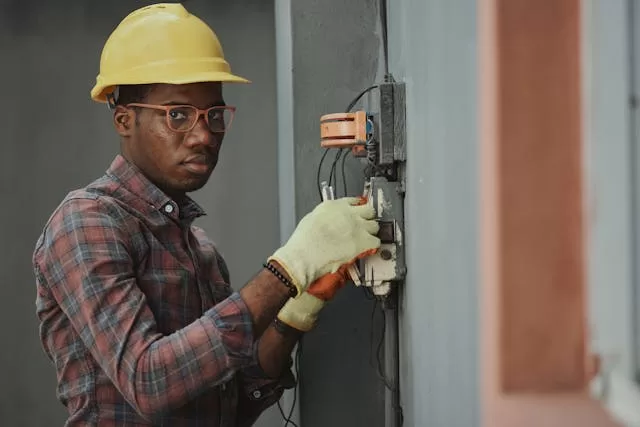DIY Electrical Concepts

Are you ready to unlock your inner electrician and become a master of electricity? Look no further than these must-have how-to books that will take you from novice to expert in no time. Whether you’re a DIY enthusiast or simply want to understand the basics of electrical systems. These electrical how to books are your ticket to success.
With easy-to-follow instructions and step-by-step illustrations. These books break down complex electrical concepts and make them accessible to everyone. You’ll learn how electricity works, and how to safely install electrical wiring. How to troubleshoot common electrical problems, and so much more.
Not only are these electrical how to books informative. But they also empower you to take control of your electrical projects. Saving you time and money. Say goodbye to expensive electrician bills and hello to DIY success.
So, if you’re ready to harness the power of electricity and unleash your inner electrician, these must-have electrical how-to books are your ultimate guide. Get ready to light up your knowledge and become the go-to expert in all things electrical.
Importance of understanding electricity
Electricity is an essential part of our everyday lives. From powering our homes to fueling our technological devices, it plays a crucial role in modern society. However, many people lack a fundamental understanding of electricity, which can lead to confusion and even dangerous situations.
Understanding electricity is important for several reasons. Firstly, it allows you to safely navigate and troubleshoot electrical systems in your home or workplace. By understanding the basics of electricity, you can identify potential hazards and take necessary precautions to prevent accidents. Additionally, having a solid grasp of electrical concepts enables you to effectively communicate with professionals, such as electricians or engineers, when seeking assistance or advice.
Moreover, mastering electricity gives you the confidence to tackle electrical projects on your own. Whether it’s installing a new light fixture or wiring a room, having the knowledge and skills to handle electrical work empowers you to take control of your projects. This not only saves you money but also gives you a sense of accomplishment and independence.
In conclusion, understanding electricity is vital for safety, effective communication, and personal empowerment. With the right resources and a willingness to learn, anyone can become proficient in the world of electricity.
Basic electrical concepts and terminology
Before diving into the world of electrical work, it’s essential to familiarize yourself with the basic concepts and terminology. This foundation will help you grasp more complex electrical principles and enable you to confidently approach electrical projects.
At its core, electricity refers to the flow of electrical charge. This charge is carried by tiny particles called electrons, which move through conductive materials such as wires. Understanding the flow of electrons and how they interact with various components is key to understanding electrical systems.
To navigate the world of electricity, you need to be familiar with common electrical terms. Some essential terms include voltage, current, resistance, and power. Voltage, measured in volts (V), refers to the force that pushes the electrical charge through a circuit. Current, measured in amperes (A), represents the flow of electrons in a circuit. Resistance, measured in ohms (Ω), is the opposition to the flow of electrical current. Power, measured in watts (W), is the rate at which electrical energy is being converted or consumed in a circuit.
By understanding these basic concepts and terminology, you’ll be better equipped to comprehend the more complex aspects of electricity. It’s like building a strong foundation for a house – without it, everything else becomes shaky and unstable.
Essential tools and equipment for electrical work
To successfully tackle electrical projects, it’s important to have the right tools and equipment at your disposal. The following are some essential tools that every aspiring electrician should have in their toolkit.
- Wire Strippers: Wire strippers are used to remove the insulation from electrical wires. They have various-sized cutting slots to accommodate different wire gauges.
- Needle-nose Pliers: These long, slender pliers with pointed tips are ideal for gripping and bending wires in tight spaces.
- Screwdrivers: A set of screwdrivers with different sizes and types of heads is essential for loosening and tightening screws in electrical devices and equipment.
- Voltage Tester: A voltage tester is used to determine whether an electrical circuit is live or not. It helps ensure your safety by detecting the presence of electricity.
- Multimeter: A multimeter is a versatile tool that combines various electrical measuring functions, including voltage, current, and resistance. It’s a must-have for troubleshooting electrical problems.
- Circuit Breaker Finder: This handy device helps locate specific circuit breakers in your electrical panel. It saves time and eliminates guesswork when working on specific circuits.
- Fish Tape: Fish tape is a flexible, flat metal tape used for pulling wires through conduits or wall cavities. It’s a valuable tool for running wires in hard-to-reach places.
Having these essential tools will make your electrical projects much easier and safer. Investing in quality tools will also ensure their longevity, allowing you to rely on them for years to come.
Safety precautions when working with electricity
Working with electricity can be dangerous if proper safety precautions are not followed. Electrocution and electrical fires are serious risks that can be avoided by taking the necessary safety measures. Here are some essential safety precautions to keep in mind when working with electricity.
- Turn off the power: Before starting any electrical work, always turn off the power to the circuit you’ll be working on. This can be done by flipping the corresponding circuit breaker or removing the fuse.
- Use personal protective equipment (PPE): When working with electricity, it’s crucial to protect yourself. Wear insulated gloves, safety goggles, and non-conductive footwear to prevent electric shocks and injuries.
- Inspect your tools and equipment: Before using any tools or equipment, ensure they are in good working condition. Check for any damaged or frayed cords that could pose a safety hazard.
- Avoid water and wet conditions: Water is an excellent conductor of electricity, so it’s important to keep your work area dry. Avoid working on electrical projects in wet conditions or near water sources.
- Properly label circuits: If you’re working on a circuit breaker panel, make sure each circuit is clearly labeled. This will help prevent accidentally working on the wrong circuit and ensure your safety.
- Never work on live circuits: Unless necessary, avoid working on live circuits. Always turn off the power and use a voltage tester to confirm that the circuit is not live before starting any work.
- Know your limits: Electrical work can be complex and potentially dangerous. If a project exceeds your knowledge or skill level, it’s best to consult a professional electrician to avoid any risks.
By following these safety precautions, you can significantly reduce the risk of accidents and injuries when working with electricity. Safety should always be the top priority when undertaking any electrical project.
Step-by-step guide to wiring a basic circuit
Wiring a basic circuit is a fundamental skill that every aspiring electrician should master. Whether you’re installing a new light switch or adding an outlet, understanding how to wire a circuit is crucial. Here is a step-by-step guide to help you navigate the process.
- Turn off the power: Before starting any electrical work, turn off the power to the circuit you’ll be working on. This can be done by flipping the corresponding circuit breaker or removing the fuse.
- Gather the necessary materials: Ensure you have all the materials and tools needed for the wiring project. This may include wires, switches, outlets, and electrical boxes.
- Plan the circuit: Determine the path the wires will take and plan where the switches and outlets will be located. This will help ensure efficient wiring and avoid any unnecessary mistakes.
- Prepare the wires: Strip the insulation from the ends of the wires using wire strippers. Make sure to leave enough exposed wire to make secure connections.
Basic Circuit Wiring- Electrical How to Books
- Connect the wires: Make the necessary connections according to your circuit plan. This may involve connecting wires to switches, outlets, or other components.
- Secure the connections: Use wire nuts or electrical tape to secure the connections and prevent any exposed wires. Make sure all connections are tight and properly insulated.
- Install the components: Install the switches, outlets, or other components in the electrical boxes according to your circuit plan. Ensure they are properly secured and aligned.
- Test the circuit: Once the wiring is complete, turn the power back on and test the circuit using a voltage tester or a light bulb. This will help ensure that everything is functioning properly.
By following these steps, you can wire a basic circuit with confidence. However, it’s important to note that more complex circuits or projects may require additional knowledge and expertise. If you’re unsure, it’s best to consult a professional electrician.
Troubleshooting common electrical issues
Electrical problems can occur at any time, causing frustration and inconvenience. However, with a basic understanding of electrical systems and some troubleshooting skills, you can often identify and resolve common electrical issues on your own. Here are some common electrical problems and troubleshooting techniques.
- No power: If you have no power in a specific area of your home, check the circuit breaker panel to see if any breakers have tripped. If a breaker has tripped, simply reset it. If the problem persists, there may be a wiring issue that requires professional assistance.
- Flickering lights: Flickering lights can be caused by loose connections or a faulty light fixture. Check the connections at the light switch and the light fixture to ensure they are secure. If the problem persists, it may be a sign of a larger electrical issue and should be inspected by a professional.
- Tripping circuit breakers: If a circuit breaker frequently trips, it may be due to an overloaded circuit. Identify the devices or appliances connected to the circuit and try reducing the load by unplugging unnecessary items. If the problem continues, consult an electrician to assess the circuit’s capacity.
Electrical How to Books Troubleshooting Techniques
- Intermittent power loss: Intermittent power loss can be caused by loose connections or faulty wiring. Check the connections at outlets, switches, and light fixtures to ensure they are secure. If the issue persists, it may require professional troubleshooting.
- GFCI outlets tripping: Ground Fault Circuit Interrupter (GFCI) outlets are designed to protect against electrical shock. If a GFCI outlet keeps tripping, it may indicate a ground fault or a defective appliance. Try unplugging all devices from the outlet and resetting it. If it continues to trip, consult an electrician.
- Buzzing or humming sounds: Buzzing or humming sounds coming from electrical devices could indicate loose connections or a faulty component. Turn off the power and check the connections at the affected device. If the noise persists, it may be best to have a professional inspect the device.
- Overheating outlets or switches: Outlets or switches that feel hot to the touch may indicate an electrical problem. Turn off the power and inspect the wiring connections. If the issue continues, it may be a sign of a larger electrical issue and should be addressed by a professional.
By troubleshooting these common electrical problems, you can often resolve issues without the need for professional assistance. However, always prioritize your safety and consult a qualified electrician if you’re unsure or uncomfortable with any aspect of electrical troubleshooting.
Advanced electrical concepts and techniques
Once you have a solid understanding of the basic electrical concepts and have mastered the fundamentals of electrical work, you may be ready to explore more advanced concepts and techniques. Here are some areas of electrical work that you can delve into for further knowledge and expertise.
- Home automation: Home automation involves integrating electrical devices and systems in your home to enhance convenience, comfort, and energy efficiency. This can include smart lighting, thermostats, security systems, and more. Learning about home automation can open up new possibilities for controlling and managing electrical systems in your home.
- Renewable energy systems: With the increasing focus on sustainability, renewable energy systems, such as solar panels or wind turbines, are becoming more popular. Understanding how these systems work and how to integrate them into existing electrical systems can be valuable knowledge in the modern world.
- Industrial electrical systems: If you’re interested in pursuing a career in the electrical industry, learning about industrial electrical systems is essential. This involves understanding large-scale electrical systems used in factories, power plants, and other industrial settings. Topics may include motor control, power distribution, and electrical safety in industrial environments.
Electrical How to Books Concepts Continued
- Electrical codes and regulations: Familiarizing yourself with electrical codes and regulations is crucial for ensuring compliance and safety in electrical work. Codes and regulations vary by location, so it’s important to stay up-to-date with the requirements specific to your area. This knowledge will help you navigate electrical projects with confidence and avoid potential legal issues.
- Energy-efficient electrical systems: Energy efficiency is a growing concern, and understanding how to design and implement energy-efficient electrical systems can be a valuable skill. This may involve learning about energy-efficient lighting, HVAC systems, insulation, and other energy-saving techniques.
By expanding your knowledge of these advanced electrical concepts and techniques, you can position yourself as an expert in the field. Whether you’re looking to pursue a career in electrical engineering or simply want to enhance your DIY skills, these areas offer exciting opportunities for growth and innovation.
Recommended Electrical how-to books for electricity
To truly master electricity, it’s important to have reliable resources at your disposal. Here are some highly recommended how-to books that cover a range of electrical topics and provide valuable guidance for beginners and experienced individuals alike.
- “Electrical Wiring Residential” by Ray C. Mullin and Phil Simmons: This comprehensive guide covers the basics of residential electrical wiring, including planning, installation, and troubleshooting. It’s a must-have resource for anyone looking to tackle electrical projects in their home.
- “Electronics All-in-One For Dummies” by Doug Lowe: This book covers various electronics topics, including electrical circuits, components, and troubleshooting techniques. It’s a great resource for beginners who want to understand the fundamentals of electronics.
- “The Complete Idiot’s Guide to Electrical Repair” by Terry Meany: This user-friendly guide covers common electrical repairs and troubleshooting techniques. It’s an excellent resource for homeowners who want to tackle small electrical issues without the need for professional assistance.
- **”National Electrical Code Handbook” by National












































































































